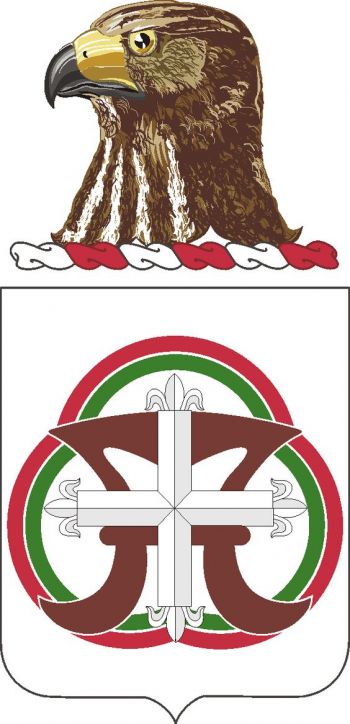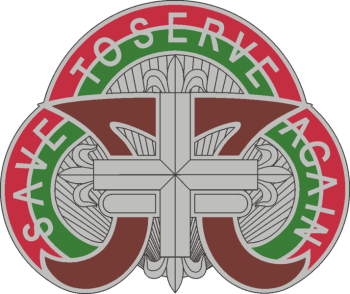109th Medical Battalion, Iowa Army National Guard: Difference between revisions
Knorrepoes (talk | contribs) m (Text replacement - "|Arms of {{PAGENAME}}]]" to "|Coat of arms (crest) of {{PAGENAME}}]]") |
Knorrepoes (talk | contribs) m (Text replacement - "↵↵↵Literature" to " Literature") |
||
| Line 22: | Line 22: | ||
The arms were approved on 16 August 2001. The Distinctive Unit Insignia was approved on 17 December 1968. | The arms were approved on 16 August 2001. The Distinctive Unit Insignia was approved on 17 December 1968. | ||
[[Literature]]: Image from Olompvo on Pinterest. Information from The Institute of Heraldry, US Army. | [[Literature]]: Image from Olompvo on Pinterest. Information from The Institute of Heraldry, US Army. | ||
Revision as of 18:27, 20 August 2023
109TH MEDICAL BATTALION, IOWA ARMY NATIONAL GUARD
(Coat of Arms) |
(Distinctive Unit Insignia) |
Official blazon
Shield: Argent, a trefoil Gules voided bearing a trefoil Vert voided fimbriated of the first, surmounted by a water bouget Sanguine superimposed by a cross fleury Argent.
Crest: That for the regiments and separate battalions of the Iowa Army National Guard: From a wreath Argent and Gules, a hawk's head erased Proper.
Motto: SAVE TO SERVE AGAIN.
Distinctive Unit Insignia. Description: A silver color metal and enamel device 1 3/16 inches (3.02 cm) in height overall consisting of a maroon water bouget surmounted by a white (silver) cross fleury extending to the inner edge of a red and green scroll tri-arched left, top and right from behind the bouget and bearing the inscription on the left "SAVE" on the top "TO SERVE" and on the right "AGAIN" all in white (silver) letters.
Origin/meaning
Coat of Arms: Maroon and white are the colors traditionally used for the Medical Battalions. The water bouget is a medieval heraldic charge symbolizing the carrying of relief to the combatant and weary, while the cross is representative of the humanitarian ideals of medical activity. The cross fleury relates to fleurs-de-lis and is used to represent the unit's campaigns of Normandy, Northern France, Rhineland and Central Europe of WWII. The voided red and green trefoils refer to the Belgian Fourragere awarded the organization for Belgian and Meuse River action.
Distinctive Unit Insignia: Maroon and white (silver) are the colors used for the Medical Battalions. The water bouget is a medieval heraldic charge symbolizing the carrying of relief to the combatant and weary, while the cross is representative of the humanitarian ideals of medical activity. The fleury relates to fleurs-de-lis, and is used to represent the unit's campaigns of Normandy, Northern France, Rhineland and Central Europe of World War II. The red and green colors of the scroll refer to the Belgian Fourragere awarded the organization for Belgian and Meuse River action.
The arms were approved on 16 August 2001. The Distinctive Unit Insignia was approved on 17 December 1968.
Literature: Image from Olompvo on Pinterest. Information from The Institute of Heraldry, US Army.

